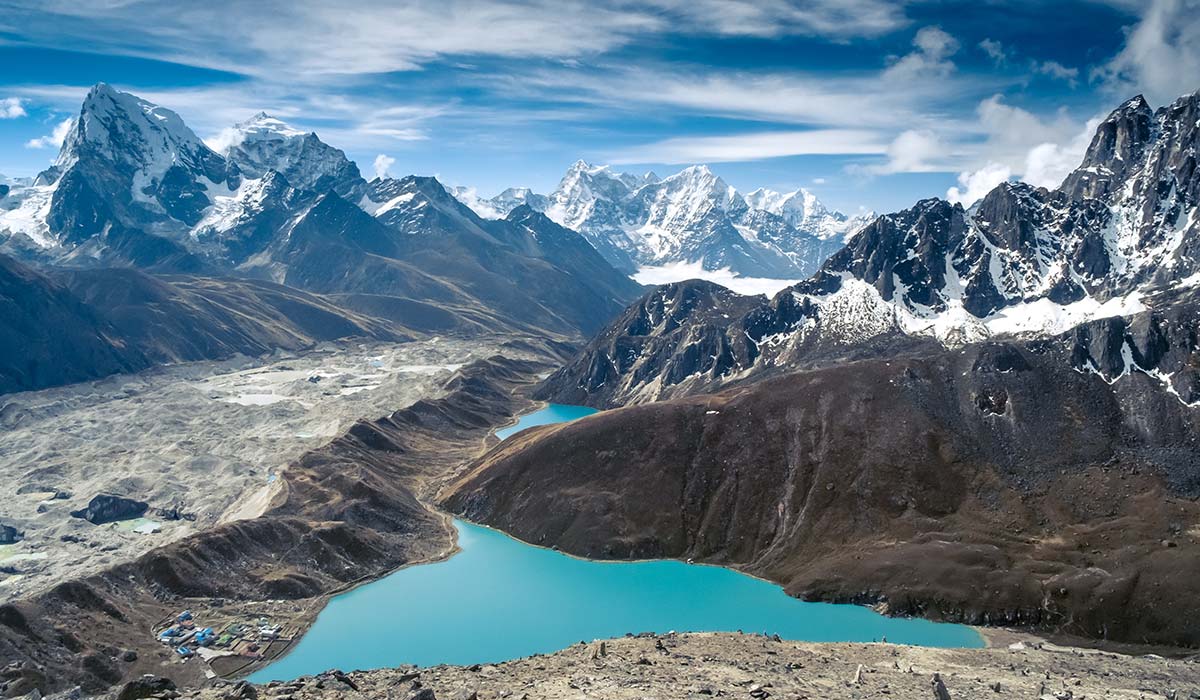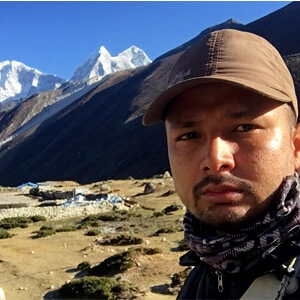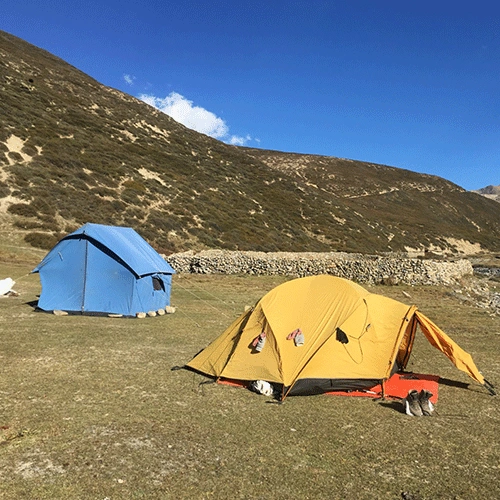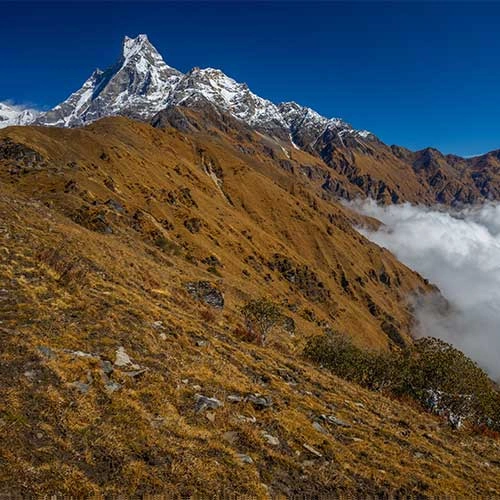Key Factors Influencing Gokyo Trek Difficulty
Although the overall Gokyo Ri Trek difficulty is at a moderate level, there are many aspects that contribute to the overall difficulty scale. Let’s break down some of those major factors that you will have to be careful about during your trek.
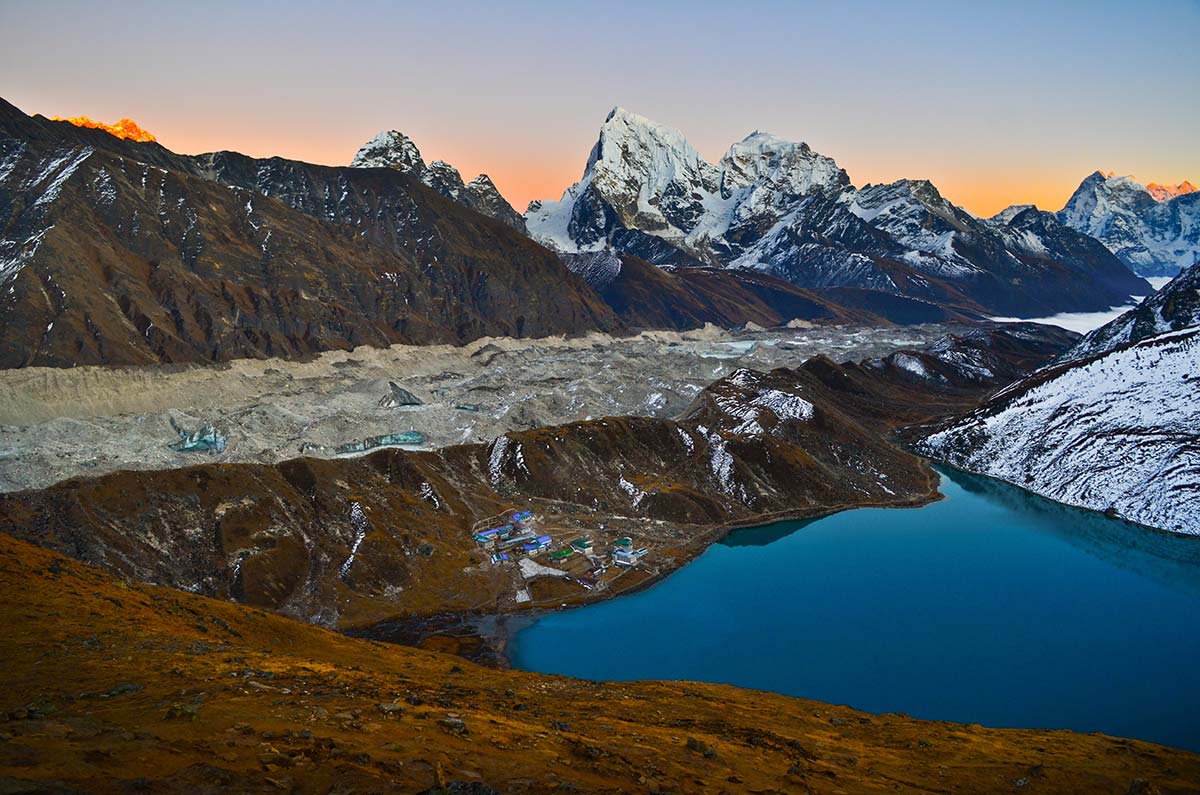
Altitude Sickness
As this exciting high freshwater lake system exploration takes you to major altitudes in the region, there is a risk of altitude sickness. Even if the risk of Acute Mountain Sickness (AMS) is not as dangerous as other altitude sicknesses, it still is quite bothersome.
You will begin your trek at Lukla (2,800m) and gradually head toward Gokyo Lake (4,700m) on the ascending route. The highest point of this trek is Gokyo Ri(5,357m). Thus the total altitude gain of this trek comes out to be around 657m (2,155m), which is quite significant.
That’s why it is important to acclimatize properly and follow appropriate precautionary methods to mitigate the risks of Gokyo Trek difficulty.
Trail Conditions
Even if you are taking on the mainstream trails of the Everest region, it is still a remote part of the Himalayas. During your trek you will have to take on the rugged mountain trails which can be a demanding factor of Gokyo Lake Trek difficulty if you are not physically prepared for it
During this high altitude journey you will have to traverse across varied terrains. From rocky trails, steep sections, narrow ridges to loose gravel and moraines. It is important to carefully navigate your way across these varied terrains strictly following the instructions of your guide.
Similarly, as you start gaining altitude, even doing simple tasks can be very demanding due to lower oxygen levels in the atmosphere. That is why trekking at higher altitudes can be more energy draining than the lower regions.
Weather Conditions
Another factor that determines how hard is Gokyo Trek is the weather aspects. Depending on the season of your visit it influences the overall Gokyo Ri Trek difficulty.
The peak period for trekking such as spring(March to May) and autumn (September to November) are considered the most suitable period for a remarkable experience. As the weather is favorable during these seasons you will not have to deal with additional weather related challenges during your trip.
However, in case if you are doing this trek in low seasons like monsoon (June to August) and winter (December to February), you will have to deal with an extra set of weather related challenges. Monsoon season sees continuous rainfall that makes trails difficult and slippery. Similarly, the risk of natural disasters like landslides and floods also increases during this period.
As for your trek in winter, you will have to deal with the freezing climatic conditions. Similarly, the snow covered trails, lack of facilities, difficulty in acclimatization, etc, are some other downsides of the winter trek.
Trekking Distance and Duration
Gokyo Lake Trek is a long Himalayan journey that last over 11 days. On this exciting trail of the Everest region, you will cover a total trekking distance of 98 km (60.89 miles).
So, it is a long trip where you will need to walk around 5 to 6 hours during the trekking days on average. It may not seem like a big deal to the experienced trekkers but walking for such long hours on the mountain trail can be quite physically draining.
Thats why the trekking hours and distance are also one of the demanding factors of Gokyo Lake Trek difficulty. If you don’t have any high altitude trekking experience and are planning to take on these mountain trails without any training, it can really be a tough nut to crack.
Physical Fitness Requirements
During this major highlight exploration of the Everest region, you will need to walk on the physically demanding and high altitude trails. Thus, to secure a comfortable journey and reduce the overall Gokyo Trek difficulty, a good level of strength is a must.
You will require at least a basic level of fitness and need to prepare in length. Considering the physical demands of the trail, the trek can be challenging for those who don’t make the required level of preparation.
Walking long hours on the trail carrying your backpack at rising altitudes is certainly a demanding task on this mountain journey. A good level of fitness and some prior high altitude trekking experience will certainly be helpful.
However, for inexperienced trekkers and those lacking a good level of fitness, the preparation is an unskippable part. It can be physically exhausting to try to do this trek without a good level of preparation.
Health and Safety
Another major factor of Gokyo Trek difficulty to be on the lookout for is the health and safety aspects of the trip. As this a long high altitude and remote adventure in the Himalayas the trekkers may have to deal with the general illness during their trip.
However, due to the lack of proper facilities in this secluded part of the country even general illness can be quite bothersome. There are only a few numbers of health facilities along the route.
The available medical establishments are also not properly equipped. So, during any kind of health complication trekkers will have to rely on the available options only. Similarly, if the situation gets dire during the trek the helicopter rescue operation is the only viable option.
Psychological Challenge
Although every trekker acknowledges the physically demanding factor of Gokyo Lake Trek difficulty, many overlook the psychological challenge of the trip. During this Himalayan journey you will traverse the remote part of the region that is secluded.
Due to extreme remoteness, the available services here and development aspects are also quite limited. So, the limited options along the route and the isolating part from the rest of the world can be a challenge to those who are not used to leaving their comfort zone.
Similarly, the strength and endurance demanding part of the trail can also be a pressing challenge. If you don't have a good level of mental fortitude and determination, you might feel like giving up when things start getting exhausting.
Logistic Challenges
The Himalayan region of Nepal is the most isolated and protected part of the country. You will find most of the conservation aeas and natinoal parks of the country lying in this region.protected part of the country. During your trek to the Himalayas, you will traverse across several conservation areas and national parks. Thus overseeing the required permits for the trek and sticking with the protocols and regulations is an absolute necessity for your trek.
If it's your first time doing a trek in Nepal, it can be difficult to understand the process and designated areas to apply and collect the necessary permits. Similarly, as this is the mainstream trekking destination, it receives a large number of trekkers from all around the world.
Thus, pre booking is necessary while trekking during these seasons. If you are managing a trek on your own and planning booking on arrival it may not be possible during these periods. So handling all the logistic details of your trip can be quite a bit of a challenge, especially if you are familiar with the region.
How to Tackle Gokyo Ri Trek Difficulty?
After understanding how hard is Gokyo Trek let’s discuss some of the counter measures to reduce the scale of the difficulty factors. A good preparation will help you easily overcome the difficulty aspects of this wonderful mainstream trek destination.
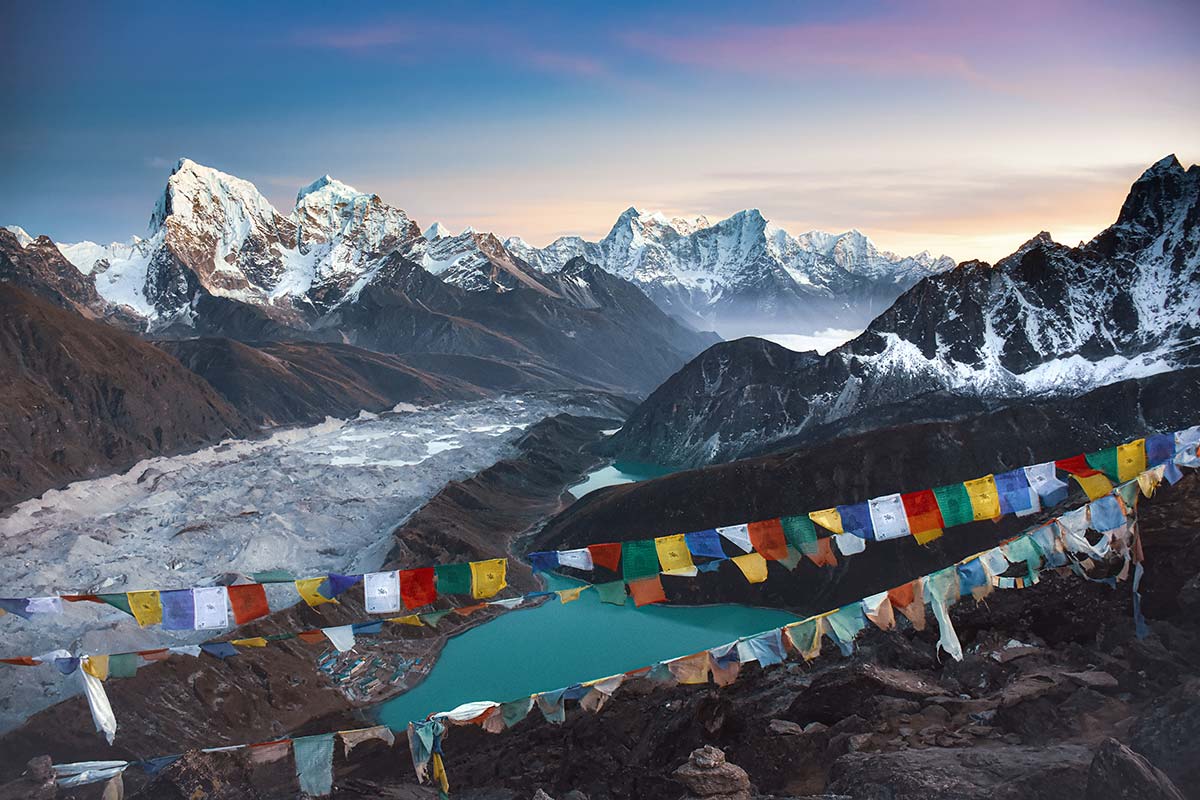
Acclimatization Tips
Rest plays a vital role in determining your comfort and experience while doing high altitude treks such as this. Thus it is important to follow the strategic acclimatization procedure to reduce the Gokyo Ri Trek difficulty.
For this you have to consider two factors while buying a package. First, check out the acclimatization period and see the walking paces. These two factors will determine how well you will adapt to rising altitudes during your trip.
Green Society Adventure’s 11 Days Gokyo Valley Trek package provides enough period for you to acclimatize to the rising altitudes. You will take it slow during this trip and will also get acclimatization day Namche to get the much deserved rest.
You will not need to worry about any risk related to altitude sickness while trekking with us. Our altitude sickness risk proof package and capable crew will make sure that you will enjoy a safe and comfortable journey.
Trekking Gear and Equipment
While doing high altitude treks in the Himalayas, it is important to understand the climatic variation along the route. It will help you to pack right for the trip, considering the climatic conditions at different altitudes.
Your journey will begin at a temperate zone (Lukla) and you will slowly walk on the rising route and reach trans Himalayan zone at Gokyo Ri (5,357m). At the lower trails, just normal layers will be sufficient and you can be casual about it
But at higher regions insulated warm layers and a buff down jacket are essential to keep yourself comfortable. Besides the climate variation, you will also need to pack right for the weather you are visiting to ensure a comfortable trip.
During the peak seasons (spring and autumn) you will be able to complete the trek with general layers and gear. However, for your trip in the off seasons (winter and monsoon), you will have to bring appropriate equipment to tackle the unfavorable weather conditions of Gokyo Lake Trek difficulty.
Eat a Balanced Diet and Stay Hydrated
Many trekkers overcome the difficulty of the Gokyo Lake Trek by eating a balanced diet. As you will be spending 9 days on the mountain, you will need take care of your immune system and eat a balanced meal.
If you properly monitor the nutrition intake, just don’t go for the taste, you will be able to keep your energy level at an optimum. Thus, with an energy level at optimum, the physically demanding trails won’t be that much of a challenge.
It will also keep your immune system strong which reduces the risk of illness during the trip. Similarly there are also several benefits of staying hydrated throughout the trek. You will be able to move around comfortably as the recommended hydration limit will balance the water level in your body.
Similarly, it will also make the acclimatization process much more easier. You don’t have to necessarily drink water all the time fresh juice and herbal tea are also quite beneficial. Just make sure that you are meeting the 3 to 4 liters of hydration quota during each day of trek.
(Note: You should avoid drinking alcohol or caffeine during the high altitude treks. Avoid cigarettes as well they are known to complicate the overall acclimatization procedure)
Physical Preparation
One of the most significant factors that helps you to reduce the Gokyo Trek difficulty is the physical preparation. If you make a good level of preparation the general difficulty factors of this trek won't be hard to overcome.
You should consider your training period from 3 to 8 weeks, depending on your fitness level. It is not necessary to put in a lot of hours for your training but it is important to stay consistent with it. This will get you used to the physical activity and prepare you for the long hours of trekking on the mountain.
For this training part your focus should be on improving your core strength, endurance, stamina and overall strength improvement. These aspects will determine your overall comfort level during the trek. So make sure you are adequately prepared on these fronts.
Take it as the more effort you will put into the training part the more it will be easier to overcome the physical demands of the trail. A good level of physical preparation will help you overcome the majority part of the Gokyo Ri Trek difficulty.
Mental Preparation
Like physical fitness it is also important to focus on the mental preparation part. During this high altitude trek, you will explore the most secluded part of the country. Due to the lack of a proper transport mode, the region lacks in the development front, which is reflected in the available services.
Similarly, the difficulty and physical draining put a lot of pressure on your mind. Thus, it is important to stay calm and composed throughout the journey. Staying positive and determined also goes a long way to completing the endeavor that you have taken on.
Here are some helpful tips that will help you prepare mentally for the overall Gokyo Trek difficulty factors:
- Set realistic goals and pace yourself throughout the trek
- Understand the challenge and make the necessary preparations that will boost your confidence
- Surround yourself with can do attitude and positive people
- Visualize your overall journey and success
- Be flexible and practice leaving your comfort zone
- Focus on staying positive and building your mental resilience
- Practice mindfulness and learn to manage your stress and anxiety
Choose a Peak Season
There are several benefits of doing the trek in Nepal during the peak seasons (spring and autumn). As these peak periods of the year also have favorable climates, this reduces the weather phenomena related factor of the Gokyo Trek difficulty.
If you trek during these period you will be able to secure a comfortable and memorable experience. Both of these seasons are popular for the incredible allure of nature at different cycles.
During the spring season, the stunning landscape is adorned with colorful flowers and lush greenery, which creates a magical setting. Similarly, it is also the most suitable period to explore the Himalayas if you are curious about the endangered flora and fauna.
On the other hand, autumn is famous as the fall cycle of nature and the most stable weather conditions. A comfortable trekking experience is guaranteed during this period of the year and the shades of the fall season provide a unique perspective to the Himalayan beauty.
Similarly, it is also a popular period for fascinating cultural experiences. Thus your trek in the peak season will not only make the journey comfortable but will also add an immersive experience of different aspects.
Trek With a Reputable Agency
If you are concerned about how hard is Gokyo Trek you can rely on the professional guidance of a reputable agency that will provide complete guidance. From handling all the necessary logistic details, managing security, following appropriate precautions and taking care of your health and comfort, an agency will handle all the aspects of your overall trip.
With reputable agencies like Green Society Adventure, which has over a decade of experience leading exciting adventures in the Himalayas, you can expect a smooth, comfortable and safe journey.
We will take care of all the details of your trip, including your safety and well being. So you can rest assured trusting us and just focus on enjoying the trip. Green Society Adventure make sure that you will enjoy a remarkable and memorable journey.
Who is Gokyo Trek Suitable for?
After understanding how hard the Gokyo Trekking adventure is, you might be wondering whether it is the right adventure for you or not. Well, if thats the case, fret not the difficulty of Gokyo Trek is at just a moderate level.
Although the different difficulty aspects of the trek may make it feel like it is an overall hard journey, but remember that all the difficulty factors are on a milder scale. You will not have to deal with any conditions that are similar to a mountain expedition.
There aren’t any technical segments along the way as well. For the majority of the part you will trek under the altitude of 5,000 meters. The only trans Himalayan point in this trek is Gokyo Ri (5,357m) which is an optional hike and you can skip it if you want.
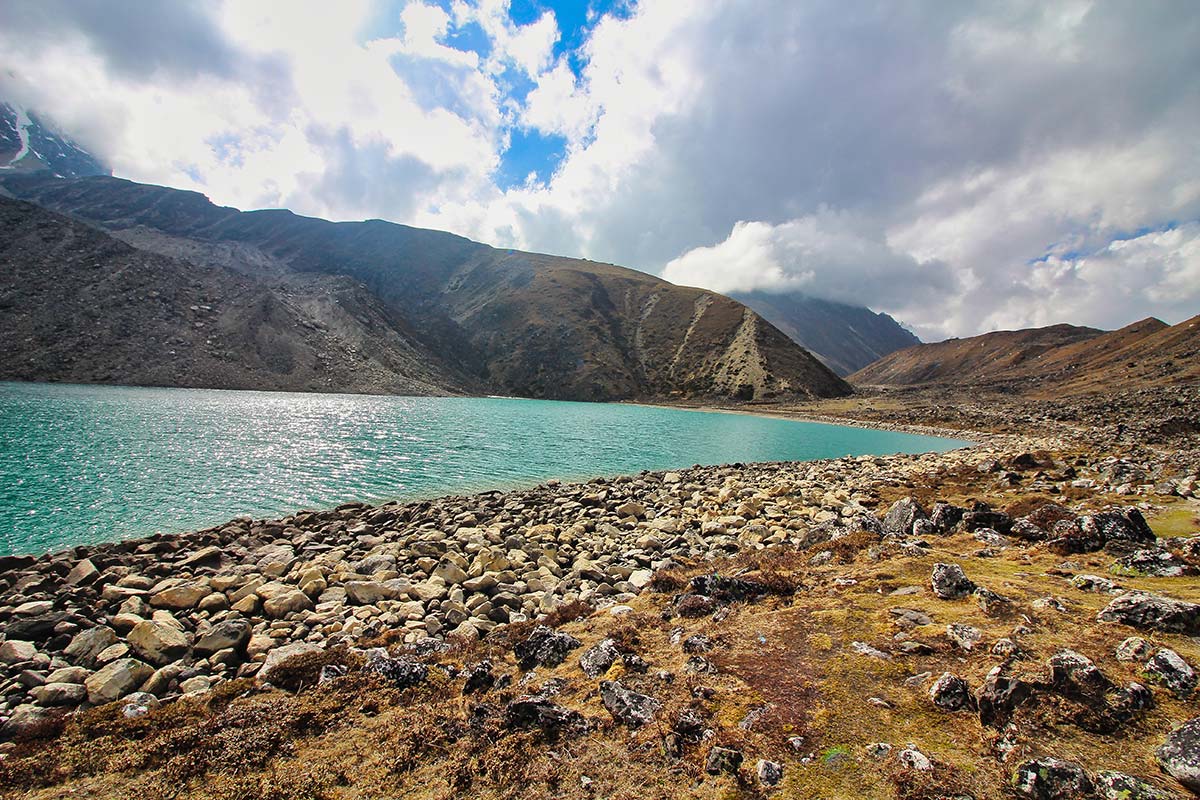
So this exciting freshwater lakes exploration is a comfortable trip even if you have to deal with the rugged mountain terrains and relatively high altitude points. If you emphasize on the preparation points it won’t be that much of a challenge for your to overcome the difficulty factors of this Himalayan trip.
There is no actual age restriction for this trip, nor are there any fitness requirements. If you are confident, determined and won’t find preparing adequately for the trip there are no restrictions for who can and cannot do this trek.
Some Additional Tips on Reducing Gokyo Trek Difficulty
- Pay attention to your body language and don’t overexert yourself
- Follow a steady pace and don’t climb too fast while ascending to higher altitudes
- Bring a first aid kit with general medicines and personal medication to last throughout the trek
- Skip meat items at higher altitudes to avoid health hazards
- Adhere to safety precautions and listen to the instructions of your guide and porters
- Don’t forget to bring healthy snacks, energy bars and electrolytes for a quick energy boost
- Stay informed and monitor weather and trail conditions
- Plan for unpredictable weather at higher altitudes and keep yourself warm
- Carry cash with your ATM and credit card services are not always reliable
- Get extensive insurance and learn about emergency procedures

